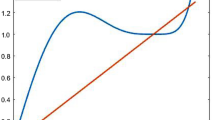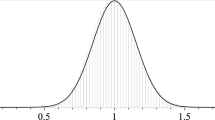Abstract
Möbius transforms, Blaschke products and starlike functions as typical conformal mappings of one complex variable give rise to nonlinear phases with non-negative phase derivatives with the latter being defined by instantaneous frequencies of signals they represent. The positive analytic phase derivative has been a widely interested subject among signal analysts (see Gabor (1946)). Research results of the positive analytic frequency and applications appears in the literature since the middle of the 20th century. Of the positive frequency study a directly related topic is positive frequency decomposition of signals. The mainly focused methods of such decompositions include the maximal selection method and the Blaschke product unwinding method, and joint use of the mentioned methods. In this paper, we propose a class of iterative greedy algorithms based on the Blaschke product and adaptive Fourier decomposition. It generalizes the Blaschke product unwinding method by subtracting constants other than the averages of the remaining functions, aiming at larger winding numbers, and subtracting n-Blaschke forms of the remaining functions, aiming at generating larger numbers of zero-crossings, to fast reduce energy of the remaining terms. Furthermore, we give a comprehensive and rigorous proof of the converging rate in terms of the zeros of the remainders. Finite Blaschke product methods are proposed to avoid the infinite phase derivative dilemma, and to avoid the computational difficulties.
Similar content being viewed by others
References
Ahern P R, Clark D N. Radial nth derivatives of Blaschke products. Math Scand, 1971, 28: 189–201
Akcay H. Discrete-time system modelling in Lp with orthonormal basis functions. Systems Control Lett, 2000, 39: 365–376
Alpay D, Bolotnikov V, Rodman L. One-sided tangential interpolation for operator-valued Hardy functions on polydisks. Integral Equations Operator Theory, 1999, 35: 253–270
Alpay D, Colombo F, Qian T, et al. Adaptive orthonormal systems for matrix-valued functions. Proc Amer Math Soc, 2017, 145: 2089–2106
Alpay D, Colombo F, Qian T, et al. Adaptative decomposition: The case of the Drury-Arveson space. J Fourier Anal Appl, 2017, 23: 1426–1444
Baratchart L, Cardelli M, Olivi M. Identification and rational L2 approximation: A gradient algorithm. Automatica, 1991, 27: 413–417
Boashash B. Estimating and interpreting the instantaneous frequency of a signal. I: Fundamental. In: Proceedings of the IEEE, vol. 80. Piscataway: IEEE, 1992, 520–538
Bultheel A, Gonzalez-Vera P, Hendriksen E, et al. Orthogonal Rational Functions. Cambridge: Cambridge University Press, 1999
Chen Q H, Li L Q, Qian T. Stability of frames generalized by nonlinear Fourier atoms. Int J Wavelets Multiresolut Inf Process, 2005, 3: 465–476
Cohen L. Time-Frequency Analysis: Theory and Applications. Upper Saddle River: Prentice Hall, 1995
Coifman R, Peyriére J. Phase unwinding, or invariant subspace decompositions of Hardy spaces. J Fourier Anal Appl, 2019, 25: 684–695
Coifman R, Steinerberger S. Nonlinear phase unwinding of functions. J Fourier Anal Appl, 2017, 23: 778–809
Coifman R, Steinerberger S, Wu H T. Carrier frequencies, holomorphy and unwinding. SIAM J Math Anal, 2017, 49: 4838–4864
Dang P, Qian T. Analytic phase derivatives, all-pass filters and signals of minimum phase. IEEE Trans Signal Process, 2011, 59: 4708–4718
Dang P, Qian T, You Z. Hardy-Sobolev spaces decomposition and applications in signal analysis. J Fourier Anal Appl, 2011, 17: 36–64
Daubechies I, Lu J F, Wu H T. Synchrosqueezed wavelet transforms: An empirical mode decomposition-like tool. Appl Comput Harmon Anal, 2011, 30: 243C261
Gallardo-Gutiérrez E, Gorkin P. Interpolating Blaschke products and angular derivatives. Trans Amer Math Soc, 2012, 364: 2319–2337
Garnett J. Bounded Analytic Functions. New York: Academic Press, 1981
Huang N E, Shen Z, Long S R, et al. The empirical mode decomposition and the Hilbert spectrum for nonlinear and non-stationary time series analysis. Proc R Soc Lond Ser A Math Phys Eng Sci, 1998, 454: 903–995
Konstantin D, Dominique Z. Variational mode decomposition. IEEE Trans Signal Proces, 2014, 62: 531–544
Li Y D, Zhang L M, Qian T. 2D partial unwinding—A novel non-linear phase decomposition of images. IEEE Trans Image Process, 2019, 47: 516–525
Mai W X, Dang P, Zhang L M, et al. Consecutive minimum phase expansion of physically realizable signals with applications. Math Methods Appl Sci, 2016, 39: 62–72
Mandic D P, Rehman N, Wu Z, et al. Empirical mode decomposition-based time-frequency analysis of multivariate signals: The power of adaptive data analysis. IEEE Signal Process Mag, 2013, 30: 74–86
Mi W, Qian T. Frequency domain identification: An algorithm based on adaptive rational orthogonal system. Automatica, 2012, 48: 1154–1162
Nahon M. Phase evaluation and segmentation. PhD Thesis. New Haven: Yale University, 2000
Picinbono B. On instantaneous amplitude and phase of signals. IEEE Trans Signal Process, 1997, 45: 552–560
Qian T. Boundary derivatives of the phases of inner and outer functions and applications. Math Methods Appl Sci, 2009, 32: 253–263
Qian T. Intrinsic mono-component decomposition of functions: An advance of Fourier theory. Math Methods Appl Sci, 2010, 33: 880–891
Qian T. Two-dimensional adaptive Fourier decomposition. Math Methods Appl Sci, 2016, 39: 2431–2448
Qian T, Sproessig W, Wang J X. Adaptive Fourier decomposition of functions in quaternionic Hardy spaces. Math Methods Appl Sci, 2012, 35: 43–64
Qian T, Tan L H. Characterizations of mono-components: The Blaschke and starlike types. Complex Anal Oper Theory, 2018, 12: 1383–1399
Qian T, Tan L H, Wang Y B. Adaptive decomposition by weighted inner functions: A generalization of Fourier series. J Fourier Anal Appl, 2011, 17: 175–190
Qian T, Wang J Z, Mai W X. An enhancement algorithm for cyclic adaptive Fourier decomposition. Appl Comput Harmon Anal, 2019, 47: 516–525
Qian T, Wang R, Xu Y S, et al. Orthonormal bases with nonlinear phases. Adv Comput Math, 2010, 33: 75–95
Qian T, Wang Y B. Adaptive Fourier series—a variation of greedy algorithm. Adv Comput Math, 2011, 34: 279–293
Qian T, Wegert E. Optimal approximation by Blaschke forms. Complex Var Elliptic Equ, 2013, 58: 123–133
Qian T, Yang Y. Hilbert transforms on the sphere with the Clifford algebra setting. J Fourier Anal Appl, 2009, 15: 753–774
Rudin W. Function Theory in Polydiscs. New York: W A Benjamin, 1969
Shapiro J H, Taylor P D. Composition Operators and Classical Function Theory. Tracts in Mathematics. New York: Springer-Verlag, 1993
Singh P, Jodhi S D, Patney R K, et al. The Fourier decomposition method for nonlinear and non-stationary time series analysis. Proc R Soc Lond Ser A Math Phys Eng Sci, 2017, 473: 20160871
Sun X Y, Dang P. Numerical stability of circular Hilbert transform and its applications to signal decomposition. Appl Math Comput, 2019, 359: 357–373
Tan L H, Qian T. Extracting outer function part from Hardy space function. Sci China Math, 2017, 60: 2321–2336
Tan L H, Shen L X, Yang L H. Rational orthogonal bases satisfying the Bedrosian identity. Adv Comput Math, 2010, 33: 285–303
Weiss G, Weiss M. A derivation of the main results of the theory of Hp-spaces. Rev Un Mat Argentina, 1962, 20: 63–71
Xu Y, Yan D Y. The Bedrosian identity for the Hilbert transform of product functions. Proc Amer Math Soc, 2006, 134: 2719–2728
Yang Y, Qian T, Sommen F. Phase derivative of monogenic signals in higher dimensional spaces. Complex Anal Oper Theory, 2012, 6: 987–1010
Yu B, Zhang H Z. The Bedrosian identity and homogeneous semi-convolution equations. J Integral Equations Appl, 2008, 20: 527–568
Acknowledgements
This work was supported by National Natural Science Foundation of China (Grant Nos. 61471132 and 11671363) and the Science and Technology Development Fund, Macau Special Administration Region (Grant No. 0123/2018/A3). The first author and the second author thank Professors Ronald Coifman and Stefan Steinerberger for their beneficial discussions during their visits to Yale University in 2018 and their helpful suggestions for the improvement of this paper. The authors are grateful to the anonymous referees for their careful reading of the manuscript and many helpful suggestions.
Author information
Authors and Affiliations
Corresponding author
Rights and permissions
About this article
Cite this article
Qian, T., Tan, L. & Chen, J. A class of iterative greedy algorithms related to Blaschke product. Sci. China Math. 64, 2703–2718 (2021). https://doi.org/10.1007/s11425-020-1706-5
Received:
Accepted:
Published:
Issue Date:
DOI: https://doi.org/10.1007/s11425-020-1706-5
Keywords
- complex Hardy space
- Möbius transform
- Blaschke product
- rational orthogonal system
- Takenaka-Malmquist system
- mono-component
- adaptive Fourier decomposition
- unwinding Blaschke expansion




